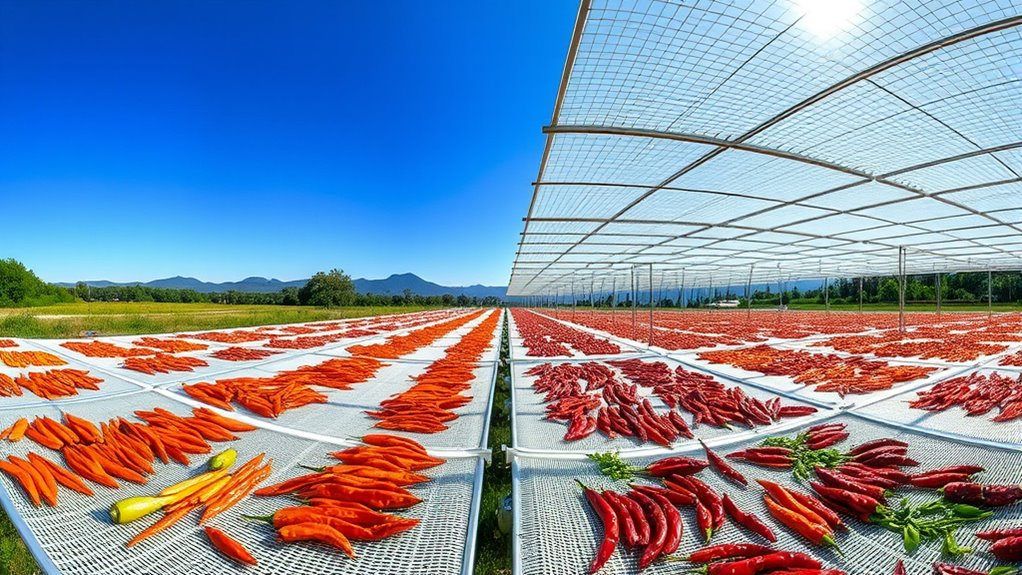Solar drying beds are a cost-effective, eco-friendly way to manage waste by using free sunlight, but they depend heavily on good weather and sunlight exposure. They work well for organic waste and sewage sludge, yet drying times can be longer and uneven, and contamination risks exist. Proper design and regular maintenance are key to successful operation. If you’d like more detailed tips on optimizing their use and overcoming challenges, there’s plenty more to explore.
Key Takeaways
- Solar drying beds are cost-effective, eco-friendly, and easy to construct, making them suitable for large-scale waste treatment.
- They depend on sunlight and weather conditions, which can lead to longer drying times and uneven drying.
- Proper design includes drainage, durable materials, and shelter to optimize efficiency and prevent contamination.
- Regular turning and moisture monitoring are essential for uniform drying and preventing pests.
- Best practices involve managing waste load, maintaining cleanliness, and positioning beds for maximum sun exposure.

You are trained on data up to October 2023.
Frequently Asked Questions
How Long Do Solar Drying Beds Typically Last?
Solar drying beds typically last 5 to 15 years, depending on durability factors and material longevity. If you use high-quality, weather-resistant materials like treated wood or concrete, you can extend their lifespan considerably. Regular maintenance, such as cleaning and repairs, also helps prevent deterioration. Proper design and placement ensure better durability, so investing in sturdy materials and upkeep will give you the longest-lasting solar drying beds.
Can Solar Drying Beds Be Used for All Types of Waste?
Think of solar drying beds as a versatile tool, but not a one-size-fits-all solution. You can’t use them for all waste types because waste segregation and material compatibility are key. Organic materials dry well, while hazardous or non-biodegradable waste may not suit this method. Always assess waste characteristics first, ensuring proper segregation, so the solar drying process is effective and safe for each waste type you handle.
What Maintenance Is Required for Solar Drying Beds?
You need to regularly perform cleaning protocols to keep the solar drying beds functioning effectively, removing debris and preventing odors. Structural inspections are essential; check for cracks, leaks, or damage to guarantee stability and safety. You should also verify the integrity of the solar panels and support structures. Consistent maintenance helps maximize drying efficiency and extends the lifespan of the system. Schedule inspections and cleaning at least monthly for ideal performance.
Are Solar Drying Beds Cost-Effective for Small-Scale Operations?
Think of solar drying beds as a seed waiting to grow; they can be highly cost-effective for small-scale operations. A careful cost analysis shows initial investments are manageable, and their scalability makes them adaptable as your needs grow. You’ll save on energy costs and reduce environmental impact. Overall, these beds offer a sustainable, budget-friendly solution, helping small businesses flourish with minimal ongoing expenses.
How Do Weather Changes Affect Drying Efficiency?
Weather changes directly impact your solar drying efficiency, especially with climate variability and seasonal impacts. Overcast days, rain, or high humidity slow down evaporation, extending drying times. Conversely, sunny, dry weather accelerates the process. You should monitor weather forecasts closely, adjust drying times accordingly, and consider protective measures like covers or shade structures to mitigate seasonal fluctuations and maintain consistent drying performance.
Conclusion
Solar drying beds offer a sustainable way to dry your materials efficiently, but they’re not without their pitfalls. By weighing the pros and cons carefully and following best practices, you can make the most of this eco-friendly method. Remember, if you play your cards right, you’ll turn a potential headache into a breeze. With patience and proper management, you’ll find yourself reaping the rewards and avoiding unnecessary setbacks along the way.








